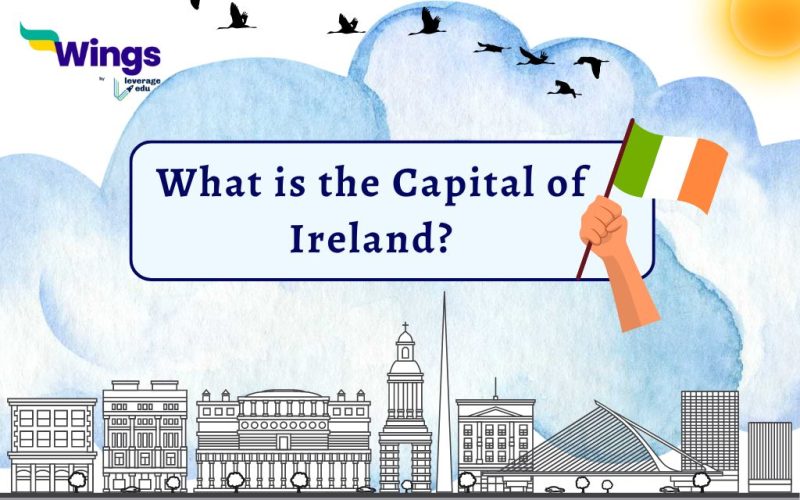The capital of Ireland is Dublin. Ireland is a country in Western Europe and despite its stunning scenery, rich cultural heritage, and the nickname “The Emerald Isle,” it also faces challenges like emigration, identity questions, and a complex relationship with Northern Ireland, which is part of the UK. In this article, we will uncover everything about what is the capital of Ireland.
Table of Contents
Overview of Dublin: Capital of Ireland
Dublin City is known for its friendliness and welcoming nature of people. Here is an overview of the capital of Ireland.
| Attribute | Details |
| City | Dublin |
| Province | Leinster |
| Location | East Coast, Irish Sea |
| Area (square miles) | 45.5 |
| Area (square km) | 118 |
| Population (2006) | 506,211 |
| Greater Dublin Population (2006) | 1,187,126 |
| Population (2011) | 527,612 |
| Greater Dublin Population (2011) | 1,273,069 |
Also Read – What Is The Capital Of Nepal?
Brief History of Dublin
Dublin Bay has been home to humans for at least 6,000 years, as evidenced by fish traps found during convention centre construction.
- Early settlements: Evidence suggests human presence near Dublin Bay for over 6,000 years. Vikings established a major foothold in 841 AD.
- Medieval Dublin: Ruled by Vikings until the Norman invasion in 1169. Dublin Castle, a symbol of British rule, was built in the 13th century.
- Tudor era and growth: Dublin became the administrative centre of Ireland under English rule. Trinity College was founded in 1592.
- Georgian Dublin (18th century): The city flourished, becoming the second-largest in the British Empire for a time. Many notable buildings like Parliament House were constructed.
- 19th century decline: After the Acts of Union, Dublin’s political and economic importance lessened. The Industrial Revolution largely bypassed the city.
- 20th century turmoil: Easter Rising, War of Independence, and Civil War caused destruction in Dublin. The city was rebuilt and became the capital of the Irish Free State (later Republic).
- Late 20th century: Major redevelopment projects transformed Dublin’s landscape. The Celtic Tiger era brought an economic boom, followed by recession and recovery.
Also Read- What Is The Capital City Of Italy?
Demography of Dublin
The demographics of Dublin mentioned below are based on the 2022 census.
| Area | Population |
| City of Dublin | 592,713 |
| Dublin City & Suburbs | 1,263,219 |
| County Dublin | 1,458,154 |
| Greater Dublin Area | 2,082,605 |
Ethnicity
| Area | White | Asian | Mixed | Black | Not Stated |
| County Dublin | 80.4% | 5.8% | 3.0% | 2.2% | 8.5% |
| Dublin City | 76.81% | 5.11% | 3.50% | 1.58% | 12.98% |
Geography of Dublin
Dublin is situated at the River Liffey, which splits the city into the Northside and Southside. Dublin Bay borders the east, while the Dublin Mountains rise to the south. Flat farmland surrounds the city to the north and west. The total urban area covers about 345 square kilometres.
Water Situation
The River Liffey is Dublin’s main waterway. The city itself was founded where the Poddle meets the Liffey. Other rivers include the Tolka, Dodder, and several smaller streams that flow into the sea. Two canals, the Grand Canal and Royal Canal, run from the west and connect to the River Shannon.
Climate
Dublin experiences a maritime climate with mild summers, cool winters, and little temperature extremes. The average July high is 20.1°C (68.2°F), while the average February low is 4.1°C (39.4°F). Dublin is the driest place in Ireland, receiving about half the rainfall of the west coast. The average annual rainfall is 726 mm (29 in). Snowfall is rare, but strong Atlantic winds are common in autumn and winter. Dublin enjoys long summer days and short winter days, with over 1,600 hours of sunshine per year along the coast.
Also Read – What is the Capital City of Himachal Pradesh?
Economy and Culture of Dublin
Dublin is the economic powerhouse of Ireland since it is the capital city.
- It led the country’s economic boom during the Celtic Tiger period.
- Dublin was ranked highly for wealth in the late 2000s but has since come down in rankings.
- A significant portion of Ireland’s professional workforce is concentrated in Dublin, particularly in finance, ICT, and other professional sectors.
The culture of Dublin is mentioned below.
- Dublin is known for its friendly people who contribute to the city’s vibrant nightlife, arts scene, and community initiatives.
- The city has produced world-famous musicians like U2 and literary giants like George Bernard Shaw.
- Dublin’s rich cultural heritage is evident throughout the city.
Facts of Dublin
There are certain amazing facts about Dublin that you might have never known.
- Formerly a marshy common used for executions and witch burnings, it’s now a beautiful park known as St. Stephen’s Green.
- Watchtowers were built to stop body snatchers, a shockingly common practice in Glasnevin Cemetery.
- Alois Hitler, half-brother of Adolf Hitler, once worked as a waiter in Dublin.
- Dublin’s Red Light District also Montgomery Street were Dublin’s red light district in Victorian times.
- Viking Graveyard in Dublin has the largest Viking graveyard outside Scandinavia, with over 40 Viking graves found along the Liffey.
FAQ
The island of Ireland is off the northwest of continental Europe, and west of Great Britain.
Ireland is known for its rich heritage, magnificent landscapes, rugged terrain, and friendly and warm people.
Irish Soda Bread, Irish Stew, Ulster Fry, Irish white pudding, and Irish coffee are some of the well-known foods of Ireland.
Related Blogs
This is everything about what is the capital of Ireland. For more such content, visit our general knowledge page.
 One app for all your study abroad needs
One app for all your study abroad needs













